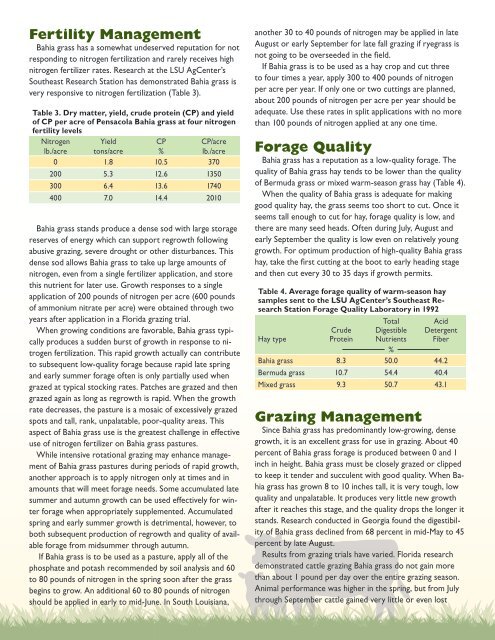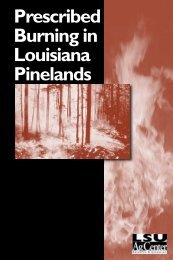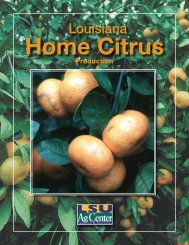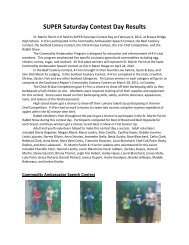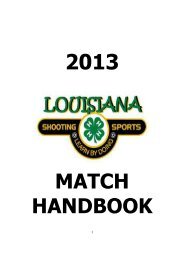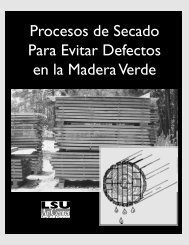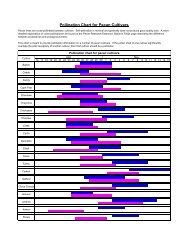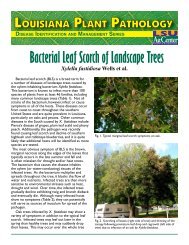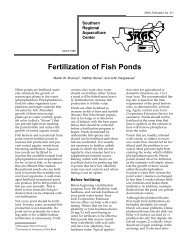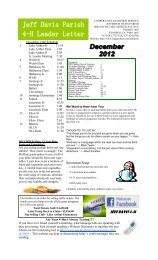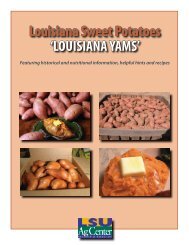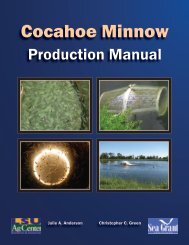Variety Descriptions - The LSU AgCenter
Variety Descriptions - The LSU AgCenter
Variety Descriptions - The LSU AgCenter
You also want an ePaper? Increase the reach of your titles
YUMPU automatically turns print PDFs into web optimized ePapers that Google loves.
Fertility Management<br />
Bahia grass has a somewhat undeserved reputation for not<br />
responding to nitrogen fertilization and rarely receives high<br />
nitrogen fertilizer rates. Research at the <strong>LSU</strong> <strong>AgCenter</strong>’s<br />
Southeast Research Station has demonstrated Bahia grass is<br />
very responsive to nitrogen fertilization (Table 3).<br />
Table 3. Dry matter, yield, crude protein (CP) and yield<br />
of CP per acre of Pensacola Bahia grass at four nitrogen<br />
fertility levels<br />
Nitrogen Yield CP CP/acre<br />
lb./acre tons/acre % lb./acre<br />
0 1.8 10.5 370<br />
200 5.3 12.6 1350<br />
300 6.4 13.6 1740<br />
400 7.0 14.4 2010<br />
Bahia grass stands produce a dense sod with large storage<br />
reserves of energy which can support regrowth following<br />
abusive grazing, severe drought or other disturbances. This<br />
dense sod allows Bahia grass to take up large amounts of<br />
nitrogen, even from a single fertilizer application, and store<br />
this nutrient for later use. Growth responses to a single<br />
application of 200 pounds of nitrogen per acre (600 pounds<br />
of ammonium nitrate per acre) were obtained through two<br />
years after application in a Florida grazing trial.<br />
When growing conditions are favorable, Bahia grass typically<br />
produces a sudden burst of growth in response to nitrogen<br />
fertilization. This rapid growth actually can contribute<br />
to subsequent low-quality forage because rapid late spring<br />
and early summer forage often is only partially used when<br />
grazed at typical stocking rates. Patches are grazed and then<br />
grazed again as long as regrowth is rapid. When the growth<br />
rate decreases, the pasture is a mosaic of excessively grazed<br />
spots and tall, rank, unpalatable, poor-quality areas. This<br />
aspect of Bahia grass use is the greatest challenge in effective<br />
use of nitrogen fertilizer on Bahia grass pastures.<br />
While intensive rotational grazing may enhance management<br />
of Bahia grass pastures during periods of rapid growth,<br />
another approach is to apply nitrogen only at times and in<br />
amounts that will meet forage needs. Some accumulated late<br />
summer and autumn growth can be used effectively for winter<br />
forage when appropriately supplemented. Accumulated<br />
spring and early summer growth is detrimental, however, to<br />
both subsequent production of regrowth and quality of available<br />
forage from midsummer through autumn.<br />
If Bahia grass is to be used as a pasture, apply all of the<br />
phosphate and potash recommended by soil analysis and 60<br />
to 80 pounds of nitrogen in the spring soon after the grass<br />
begins to grow. An additional 60 to 80 pounds of nitrogen<br />
should be applied in early to mid-June. In South Louisiana,<br />
another 30 to 40 pounds of nitrogen may be applied in late<br />
August or early September for late fall grazing if ryegrass is<br />
not going to be overseeded in the field.<br />
If Bahia grass is to be used as a hay crop and cut three<br />
to four times a year, apply 300 to 400 pounds of nitrogen<br />
per acre per year. If only one or two cuttings are planned,<br />
about 200 pounds of nitrogen per acre per year should be<br />
adequate. Use these rates in split applications with no more<br />
than 100 pounds of nitrogen applied at any one time.<br />
Forage Quality<br />
Bahia grass has a reputation as a low-quality forage. <strong>The</strong><br />
quality of Bahia grass hay tends to be lower than the quality<br />
of Bermuda grass or mixed warm-season grass hay (Table 4).<br />
When the quality of Bahia grass is adequate for making<br />
good quality hay, the grass seems too short to cut. Once it<br />
seems tall enough to cut for hay, forage quality is low, and<br />
there are many seed heads. Often during July, August and<br />
early September the quality is low even on relatively young<br />
growth. For optimum production of high-quality Bahia grass<br />
hay, take the first cutting at the boot to early heading stage<br />
and then cut every 30 to 35 days if growth permits.<br />
Table 4. Average forage quality of warm-season hay<br />
samples sent to the <strong>LSU</strong> <strong>AgCenter</strong>’s Southeast Research<br />
Station Forage Quality Laboratory in 1992<br />
Hay type<br />
Crude<br />
Protein<br />
Total<br />
Digestible<br />
Nutrients<br />
Acid<br />
Detergent<br />
Fiber<br />
%<br />
Bahia grass 8.3 50.0 44.2<br />
Bermuda grass 10.7 54.4 40.4<br />
Mixed grass 9.3 50.7 43.1<br />
Grazing Management<br />
Since Bahia grass has predominantly low-growing, dense<br />
growth, it is an excellent grass for use in grazing. About 40<br />
percent of Bahia grass forage is produced between 0 and 1<br />
inch in height. Bahia grass must be closely grazed or clipped<br />
to keep it tender and succulent with good quality. When Bahia<br />
grass has grown 8 to 10 inches tall, it is very tough, low<br />
quality and unpalatable. It produces very little new growth<br />
after it reaches this stage, and the quality drops the longer it<br />
stands. Research conducted in Georgia found the digestibility<br />
of Bahia grass declined from 68 percent in mid-May to 45<br />
percent by late August.<br />
Results from grazing trials have varied. Florida research<br />
demonstrated cattle grazing Bahia grass do not gain more<br />
than about 1 pound per day over the entire grazing season.<br />
Animal performance was higher in the spring, but from July<br />
through September cattle gained very little or even lost


